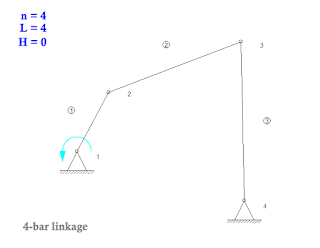 |
| Mechanism with 1 degree of freedom |
We can use Gruebler's equation to calculate the number of degrees of freedom of the mechanism as follows.
F = number of degrees of freedom
n = total number of links in the mechanism
L = total number of lower pairs (1 DOF such as pins and sliding joints)
H = total number of higher pairs (2 DOF such as cam and gear joints)
 |
| 4-bar linkage |
- n = 4 --- 4 links
- L = 4 --- 4 revoulte joints
- H = 0 --- no higher pairs
- F = 3(4-1) - 2(4) - 0 = 1
Another example of 1 DOF mechanism is the slider-crank mechanism where it has the following number of links and joints.
 |
| Slider-Crank Mechanism |
- n = 4 --- 2 links + 1 ground link + 1 slider
- L = 4 --- 3 pins + 1 slider
- H = 0 --- no higher pairs
- F = 3(4-1) - 2(4) - 0 = 1
The gears mechanism also has 1 DOF since it has the following values.
 |
| Gears Mechanism |
- n = 3 --- 2 gears + 1 ground link
- L = 2 --- 2 revolute joints
- H = 1 --- 1 gear joint
- F = 3(3-1) - 2(2) - 1 = 1
These 3 examples have 1 degree of freedom which requires only 1 actuator to move the mechanism. It could be a motor, an air cylinder, etc.
If we change the slider joint of the slider-crank mechanism to the fixed pin joint, the mechanism will be locked since it has 0 DOF which is considered as a structure. The calculation using Gruebler's equation is as follows.
 |
| Structure: Degree of freedom = 0 |
- n = 3 --- 2 links + 1 ground link
- L = 3 --- 3 pin joints
- H = 0 --- no cam or gear joints
- F = 3(3-1) - 2(3) - 0 = 0 --- F=0 then it can't move.
If one of the pin joint of the 4-bar linkage changes to the slider joint, it will increase both the number of links and number of lower pairs. This makes the mechanism unconstrained because it has 2 DOF and required 2 actuators to control the position of the mechanism.
- n = 5 --- 3 links + 1 slider + 1 ground link
- L = 5 --- 4 pin joints + 1 slider joint
- H = 0 --- no higher pairs
- F = 3(5-1) - 2(5) - 0 = 2 --- F > 1, the mechanism is unconstrained.
References:
- Machines & Mechanisms 3rd Edition, David H. Myszka
- 4 Basic Kinematics of Constrained Rigid Bodies
- Linkages sketch and animation using SAM 7.0 Mechanism Design Software





























































